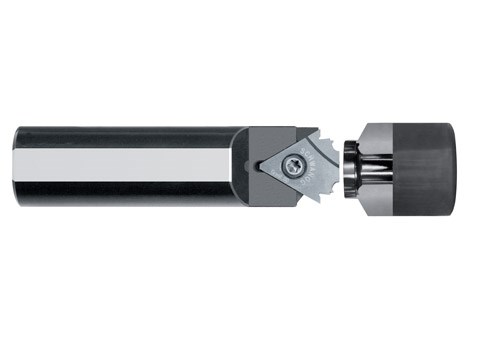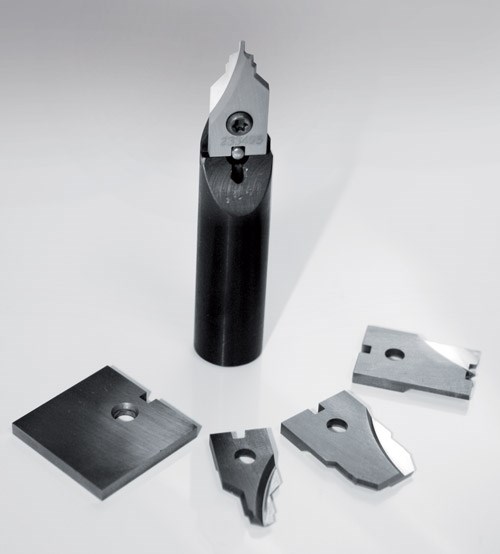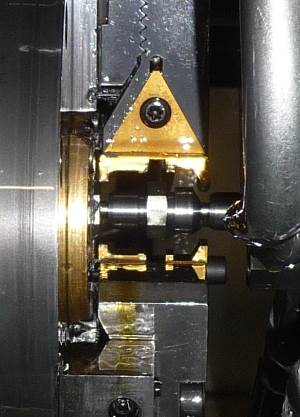Insertable Form Drill System for Maximum Efficiency
In many applications, the switch from solid carbide drills to insertable form drills has shown to provide unit cost reductions of as much as 40 percent. As the demand for highly complex parts continues to rise, production improvements such as these become even more significant.
In many applications, the switch from solid carbide drills to insertable form drills has shown to provide unit cost reductions of as much as 40 percent. As the demand for highly complex parts continues to rise, production improvements such as these become even more significant. But the hesitation for the use of solid carbide drills often comes from longer change-over times, and thus higher costs because of machine downtime.
With its PWP insertable form drill system, Schwanog addresses the problem of high setup times. The system consists of a holder, retaining screw and an insert that is individually ground according to the customer’s drawing. During tool change-over, the insert holder stays untouched in the machine, resulting in the center height remaining unchanged. These form drills can hold the process safe within a minimum tolerance of ± 0.03 mm.To complement the PWP system, the PWP-D system offers wider inserts, achieving a maximum drill diameter of 28 mm. Both form drill systems are available in various carbide grades.
Making the Cut
According to Holger Johannsen, general manager at Schwanog LLC (Elgin, Ill.), the form drill system offers a few advantages compared with a solid carbide drill, but the most significant is in setup time. With the solid carbide drill, when the tool is worn, the entire drill is removed for re-sharpening, and then the operator needs to bring it back on center. This process causes machine downtime. “With the insertable tool, you have easy access to the retaining screw in the machine. You open it up, take the insert out, and replace it with a new insert and lock it down. You leave the holder alone,” Mr. Johannsen says. “So you have an immense increase in machine uptime through setup time reduction.”
As with the company’s OD form tools, these tools are ground, allowing for quality surface finishes while achieving highly complex geometries. Mr. Johannsen also mentions the potential cost savings in replacing an insert rather than an entire solid carbide drill.
When considering costs, a shop should consider the big picture. The initial purchase of the system requires the shank holder as well, but once that is obtained, only the carbide insert (for which the price can vary, depending on the complexity of the geometry) needs to be replaced on a regular basis. So initial orders in some cases can be equal or slightly higher than that of a solid carbide drill, but subsequent orders can quickly make up the difference.
A Good Fit
As one would expect, specifics of an application determine what the best tool for the job will be. Tier 1 and Tier 2 automotive suppliers, for example, with annual production runs of millions of parts, are typically ordering quantities of 50 to 200, depending on the tool life they are achieving. And with larger-batch orders, Schwanog offers increasing discounts. When the price is right, it’s a sign of a good fit.
But not every tool works for every job, and the PWP system is limited because of its bore width (diameter) to depth ratio for certain jobs. The PWP system’s largest range is 25-mm (0.98-inch) bore diameter and 10-mm (0.40-inch) depth. Therefore, the company introduced this year its PWP-D system, which accommodates a maximum 28-mm (1.10-inches) bore diameter and 14-mm (0.55-inch) depth.
The PWP and PWP-D systems complement each other to help fill a wider need in form drilling. The PWP uses a V-style design where it mounts in the holder. The PWP-D is a square design that allows it to hold the diameter over the entire drill depth, with widths of 18, 23 or 28 mm.
If the bore diameter is too deep for the diameter of the tool, the holder may interfere with the cut. So careful consideration should be given to the application and how the drill system will be used. Schwanog assists in determining the suitability of the system for a given application during the quotation process.
“Reduced setup times due to quick tool change-overs are what our customers are most excited about with these tools,” Mr. Johannsen says. The highly complex geometries that can be achieved using an insert and improved surface finishes are added benefits that should not be overlooked.
Related Content
What Is Trochoidal Turning? How Might Shops Benefit From It?
While trochoidal milling might be a more well-known toolpath strategy, trochoidal turning can offer similar benefits such as high material removal rates especially for rough-turning operations.
Read MoreCNC Turning Tips for HRSA Materials
Rough-turning, heat-resistant superalloys can be challenging. However, new carbide insert technology provides the capability to perform high-speed, high-feed roughing in a single pass.
Read MoreNew Cutting Tool Technology Discovered at Paul Horn Open House
During a tour of the company’s campus in Tubingen, Germany, I and more than 3,000+ others were introduced to a number of new advances the company has made in cutting tool technology particularly as it relates to the medical industry.
Read MoreReplaceable-Insert Spade Drill Basics, Advantages
Although solid carbide and indexable-insert drills have their place in a machine shop, replaceable-insert spade drills offer specific advantages for various holemaking operations on machining centers and lathes.
Read MoreRead Next
Video: Form Tools On CNC Lathes
Form tools are traditionally associated with non-CNC machines, but in certain applications they make sense on modern machines as well.
Read MoreEmerging Leaders Nominations Now Open
Here’s your chance to highlight a young person in your manufacturing business who is on the path to be a future leader moving your company forward.
Read More5 Aspects of PMTS I Appreciate
The three-day edition of the 2025 Precision Machining Technology Show kicks off at the start of April. I’ll be there, and here are some reasons why.
Read More

























.png;maxWidth=970;quality=90)